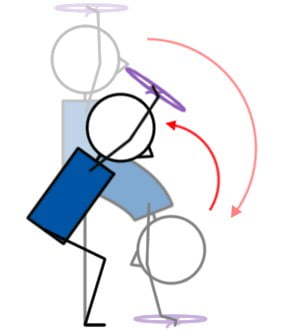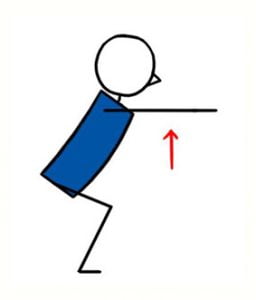
| Category: | Pilates Lesson Planner |
|---|---|
| Sub Category: | Magic Circle |
| Types: | Forward Bend, Inversion, Standing, Stretch |
| Anatomy: | Arms & Shoulders, Hamstrings, Hips, Lower Back, Middle Back, Neck, Psoas, Upper Back |
| Chakras: | Base, Sacral Centre, Solar Plexus Centre |
| Therapy: | Leg Congestion, Poor Posture, Varicose Veins |
| Drishti: | Tip Of Nose |
| Dosha: | Kapha, Pitta |
| Meridian Lines: | Stomach |
Stand straight. Hold ring between hands. Inhale, lift ring above head. Exhale, fold forward. Inhale, lift upper body while bending legs in chair position. Lift arms. Exhale fold forward. Inhale, return to start.
Stretches back and hamstrings. Strengthens legs.
Click here for lots of FREE downloadable Yoga lesson plans.
Click here for lots of FREE downloadable Pilates lesson plans.
- 15 Minute Magic Circle Challenge: Lower Body + Core
- Magic Circle Poses
- magic circle
- Magic Circle
- Magic Circle Exercises
- Magic Circle Routine
- Reformer 1
- V1 Mixed Level
- Stretch and length
- Circle
- Spine
- Spine copied lesson plan
- Clase con aro
- Spine lesson plan
- Magic 1
- Mary Pilates- Magic Circle
- Magic Circle
- Henley Magic 1
- Feb 12th Intermediate
- Magic Circle Exercises
- Magic Circle Full Body
- Debbie supplimentary
- Joe September 2020
- Magic Circle Exercises
- Magic Circle
- Magic Circle lesson
- Magic Circle Full Body
- Magic Circle class
- Magic circle 4
- Mat work Beginner
- Magic Circle Full Body
- Magic Circle Exercises
- Magic Circle Exercises
- Magic Circle Exercises
- Magic Circle Exercises
- Magic Circle Exercises
- Rings
- Magic Circle Exercises
- Magic Circle Exercises
- Pilates Ring Tuesday
- Magic circle
- Magic circle
- Matwork- Standing with ball
- ref
- 20 Lesson Magic Circle Exercises
- Melissa Week 6 Studio
- 31 pamoka Classical Mat - Supine/Sitting
- Aula 6
- 42 Pilates Ring Tuesday
- 31 pamoka Classical Mat - Supine/Sitting
- Center & Balance Flow
- Magic Circle Exercises
- 51 Mat Pilates RING
- magic circle
- Magic Circle-Class 2
- Classical Mat - Supine/Sitting MT Version
- Magic Circle Exercises
- Magic Circle Exercises
- Magic Circle Exercises
- Classical Mat - Supine/Sitting MT Version
- Classical Mat - Supine/Sitting/standing
- Magic Circle Exercises
- Full Body Pilates 2 (Intermediate)
- Ring Of Fire
- Dynamic Pilates
- Susan 03.08.24
- 2025 Magic
- All Magic Circle Exercises
- Pilates with a small ball
- Full Body Pilates 2 (Intermediate)
- Full Body Pilates 2 (Intermediate) March
- Beginners Mat Pilates 1
- Beginners Mat Pilates - May 2025
- Beginners Mat Pilates 1
- Full Body Pilates 2 (Intermediate)
- Full Body Pilates 2 (Intermediate) March
- Beginners Mat Pilates a
- Magic Circle Exercises1
- ring
- Ask Genie 2
- Magic Circle Exercises1
- Full Body Pilates 2 (Intermediate)
- Magic Circle August
- Full Body Pilates 2 (Intermediate)
- Full Body Pilates 2 (Intermediate)
- Full Body Pilates 2 (Intermediate)
- Full Body Pilates 2 (Intermediate)
- Beginners Mat Pilates a
- Beginners Mat Pilates a
- Beginners Mat Pilates a
- Beginners Mat Pilates a
Pilates Squat Pose FAQs
What are other names for Squat Pose?
- Deep squat pose
- Sitting down pose
What’s the most important thing to be aware of in a Squat pose?
Make sure that the knees are pointing in the same direction as your toes.
What should I be aware of when in a Squat pose?
Squat pose challenges will challenge your entire body because it requires mobility and stability in the ankles, knees, hips, pelvis, and spine.
When in the pose silently ask yourself these questions:
- How does it feel?
- Where do I feel it?
- Are my heels lifted (the goal is to have the heels down)?
- Are my ankles rolling in?
- Are my arches collapsed?
- Are my toes turning out excessively (or do they want to)?
- How do my knees look and feel?
- Are my knees collapsing in?
- Is one knee collapsing in more than the other?
- Is one hip closer to the ground?
- Am I leaning to one side?
- Is my spine straight, arched, or rounding forward?
- Is my tailbone tucking under excessively?
If my heels are lifted when in a Squat pose what does that mean?
If your heels are lifted, it usually indicates a limitation in the Achilles tendon and calves. Allow your heels to lift and over time, with regular practice, the heels will lower down to the floor. It may also indicate hamstring tightness, piriformis tightness, or weakness in the gluteus medius. An easy way to make the pose more accessible is to place a rolled-up towel or blanket under the heels for support. If your heels are close to the ground, try widening your feet and turning the toes out.
How wide should my stance be in a Squat pose?
Have fun experimenting with a wide and narrow stance to find the ideal Squat pose width for you. There is no one-size-fits-all.
If my heels are knees collapsed when in a Squat pose what does that mean?
If your knees are collapsed (hips are internally rotated), you may have weak gluteus muscles, tight adductors (inner thighs), or a tight iliotibial band (a band of fascia along the outside of the leg from the hip to the knee).
If my low back is arched excessively when in a Squat pose what does that mean?
If your low back arched excessively, you may have tight hip flexors that are compensating for weak core muscles.
If my spine is rounded forward when in a Squat pose what does that mean?
If your spine is rounded forward, you may have weak erector spinae muscles (iliocostalis, longissimus, and spinalis), a tight thoracic (middle) spine, or tight hamstrings.
If I lean to one side when in a Squat pose what does that mean?
Leaning to one side could mean that you have a stability problem or an asymmetry (two sides that are not the same) of the ankle, knee, or hip.
If one shoulder is higher than the other in a Squat pose what does that mean?
It’s common for the shoulder of our dominant side to be tighter, and less mobile.
What are some modifications to the Squat pose?
A) Sit on the front edge of a chair.
B) Folded blanket under heels.
C) Lift all ten toes up.
D) Bring arms to the tops of legs and reach outward.
E) Sit back against a wall like you are in a chair.
F) Add a twist.
G) Sit on a block.
H) Roll a blanket and place it in the crease of both knees.




 Yoga Lesson Planner
Yoga Lesson Planner
 Pilates Lesson Planner
Pilates Lesson Planner









